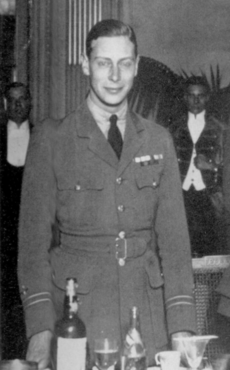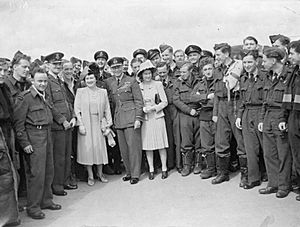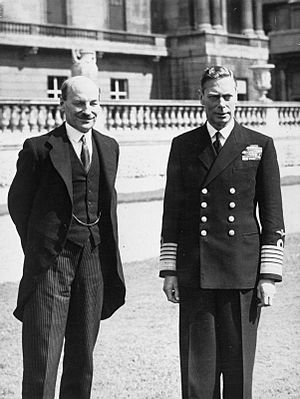George VI facts for kids
Quick facts for kids George VI |
|||||
|---|---|---|---|---|---|
| Head of the Commonwealth | |||||
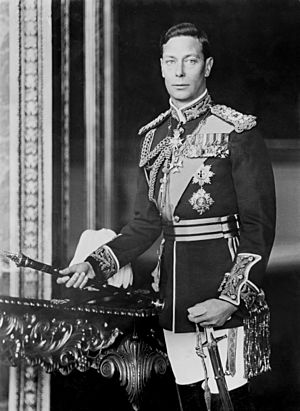
Portrait by Walter Stoneman, 1938
|
|||||
| King of the United Kingdom and the British Dominions | |||||
| Reign | 11 December 1936 – 6 February 1952 | ||||
| Coronation | 12 May 1937 | ||||
| Predecessor | Edward VIII | ||||
| Successor | Elizabeth II | ||||
| Emperor of India | |||||
| Reign | 11 December 1936 – 15 August 1947 | ||||
| Predecessor | Edward VIII | ||||
| Successor | Position abolished | ||||
| Born | Prince Albert of York 14 December 1895 York Cottage, Sandringham, Norfolk, England |
||||
| Died | 6 February 1952 (aged 56) Sandringham House, Norfolk, England |
||||
| Burial | 15 February 1952 Royal Vault, St George's Chapel, Windsor Castle
26 March 1969King George VI Memorial Chapel, St George's Chapel
|
||||
| Spouse | |||||
| Issue Detail |
|||||
|
|||||
| House |
|
||||
| Father | George V | ||||
| Mother | Mary of Teck | ||||
| Religion | Protestant | ||||
| Signature |  |
||||
George VI (born Albert Frederick Arthur George; 14 December 1895 – 6 February 1952) was the King of the United Kingdom and the Dominions of the British Commonwealth. He ruled from 11 December 1936 until his death in 1952. He was also the last Emperor of India until 1947. After that, he became the first head of the Commonwealth in 1949.
Contents
- Early life of Prince Albert
- Military career and education
- Marriage and family life
- Personality and public speaking
- Becoming King George VI
- World War II and its impact
- From Empire to Commonwealth
- Illness and death
- Legacy of King George VI
- Interesting facts about George VI
- Titles and symbols
- Issue
- Images for kids
- See also
Early life of Prince Albert
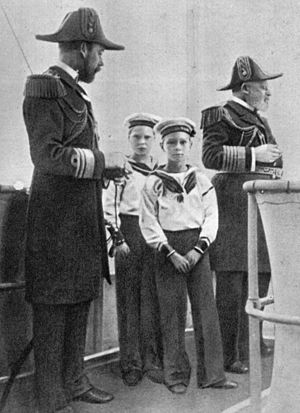
Albert was born at York Cottage in Norfolk. This was during the time of his great-grandmother, Queen Victoria. His father was Prince George, Duke of York, who later became King George V. His mother was the Duchess of York, who later became Queen Mary.
Albert was born on 14 December 1895. This was the same day his great-grandfather, Albert, Prince Consort, had died 34 years earlier. Queen Victoria was first upset by this. But she was happy when Albert's parents decided to name him after her late husband. He was named "Albert Frederick Arthur George" and was known as Prince Albert of York.
When he was born, Albert was fourth in line to the throne. This meant his grandfather, father, and older brother, Edward, would become king before him. When Queen Victoria died in 1901, her son became King Edward VII. Albert then moved up to third in line to the throne.
Military career and education
In 1909, Albert started at the Royal Naval College, Osborne, as a naval cadet. Even though he finished last in his final exam, he went on to the Royal Naval College, Dartmouth. When his grandfather Edward VII died in 1910, his father became King George V. Albert's older brother, Edward, became Prince of Wales, making Albert second in line to the throne.
Albert served in the navy during World War I. He was a turret officer on a ship called HMS Collingwood. He fought in the Battle of Jutland in 1916, which was a very big naval battle. He was mentioned for his brave actions. Later, he transferred to the Royal Air Force (RAF) in 1918. He even qualified as an RAF pilot in 1919.
In October 1919, Albert went to Trinity College, Cambridge. He studied history, economics, and civics for a year. In 1920, his father gave him the titles Duke of York, Earl of Inverness, and Baron Killarney.
Marriage and family life
In 1920, Albert met Lady Elizabeth Bowes-Lyon again. He had known her since they were children. He decided he wanted to marry her. Elizabeth said no twice because she was worried about becoming part of the royal family. But after a long time, she agreed.
Albert and Elizabeth got married on 26 April 1923 at Westminster Abbey. It was seen as a modern step because Elizabeth was not born into a royal family.
The Duke and Duchess had two daughters. Their first daughter, Elizabeth, was born in 1926. She was called "Lilibet" by her family and later became Queen Elizabeth II. Their second daughter, Margaret, was born in 1930. The family lived in a normal house in London, not a royal palace.
Personality and public speaking
As a child, Albert was often sick and was described as shy. He had a stutter that lasted for many years. He was naturally left-handed, but he was made to write with his right hand. This was common back then. He also had problems with his legs and had to wear painful braces.
His stutter made him feel less confident in public than his older brother, Edward. But he was very active and loved playing tennis. He even played in a men's doubles match at Wimbledon in 1926. He also cared about working conditions and helped with a group called the Industrial Welfare Society. He started summer camps for boys from different backgrounds, which were very popular.
Because of his stutter, Albert was afraid of speaking in public. After a difficult speech in 1925, he started working with Lionel Logue, a speech therapist. They practiced breathing exercises, and his wife helped him. This helped him speak much better. With his improved speech, Albert opened the new Parliament House in Australia in 1927. This was during a tour of the British Empire with his wife.
Becoming King George VI
On 20 January 1936, George V died. Albert's older brother became King Edward VIII. However, Edward VIII decided to give up the throne later that year. He wanted to marry an American woman named Wallis Simpson, who had been divorced twice. Because Edward gave up the throne, Albert became king. He chose the name George VI.
Albert did not want to be king. He wrote in his diary that he "sobbed like a child" when he told his mother what had happened. Some people spread rumors that Albert was not strong enough to be king. But there was no real proof of this.
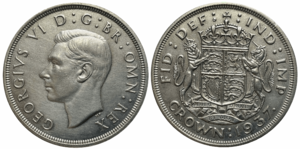
Albert chose the name "George VI" to show that he would continue his father's good work. He wanted to bring back trust in the monarchy. Three days after he became king, he made his wife, Elizabeth, a member of the Order of the Garter.
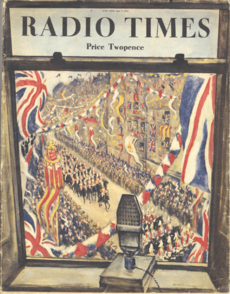
George VI's coronation was held at Westminster Abbey on 12 May 1937. This was the same date that had been planned for Edward's coronation. His mother, Queen Mary, attended the ceremony. This was unusual, but it showed her support for her son.
In 1939, the King and Queen visited Canada and the United States. This was the first time a British king had visited North America. They were welcomed with great excitement by the public. They visited the 1939 New York World's Fair and stayed with President Franklin D. Roosevelt. They became good friends with the President.
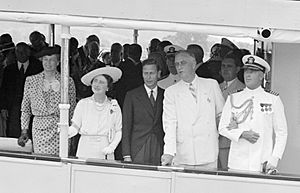
World War II and its impact
In September 1939, World War II began. The British Empire and most Commonwealth countries declared war on Nazi Germany. Later, war also started with Italy and Japan.
George VI was seen as someone who shared the difficulties of his people. His popularity grew a lot during the war. Buckingham Palace was bombed during the Blitz while the King and Queen were there. His younger brother, the Duke of Kent, was killed while serving in the war.
Throughout the war, George and Elizabeth visited bombed areas, factories, and troops. This helped boost everyone's spirits. George visited military forces in France, North Africa, Malta, Normandy, Italy, and the Netherlands. Their strong public presence and determination made them symbols of national strength.
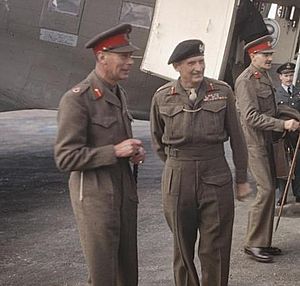
Britain and its allies won the war in 1945. But the British Empire began to change. Countries like India and Pakistan became independent in 1947. George gave up his title of Emperor of India in 1948. Instead, he took on the new title of Head of the Commonwealth.
From Empire to Commonwealth
During George VI's rule, the British Empire changed a lot. It became a group of independent countries called the Commonwealth. This change sped up after World War II.
George gave up the title of Emperor of India. He became King of India and King of Pakistan instead. In 1949, Commonwealth leaders created the London Declaration. This set up the modern Commonwealth and recognized George as its Head of the Commonwealth. In 1950, India became a republic, so he was no longer King of India. He remained King of Pakistan until he died. Other countries also left the Commonwealth, like Burma and Ireland.
Illness and death
The stress of the war and his heavy smoking affected George's health. He developed lung cancer and other serious health problems. A planned trip to Australia and New Zealand had to be postponed because of his illness. His older daughter, Elizabeth, started taking on more royal duties as her father's health got worse.
In September 1951, he had surgery to remove his left lung because of a tumor. In October 1951, Elizabeth and her husband, Philip, Duke of Edinburgh, went on a tour of Canada. In November, someone else had to read the King's speech at the State Opening of Parliament. His Christmas message in 1951 was recorded in parts and then put together.
On 31 January 1952, George went to London Airport to see Elizabeth and Philip off on their tour. This was his last public appearance. Six days later, on 6 February, he was found dead in his bed at Sandringham House. He had died in his sleep from a heart attack at age 56. His daughter, Elizabeth, flew back to Britain from Kenya as the new Queen Elizabeth II.
George's funeral was held at St George's Chapel, Windsor Castle. He was buried there. Later, in 2002, his wife, Queen Elizabeth The Queen Mother, and his younger daughter, Princess Margaret, were also buried with him. In 2022, Queen Elizabeth II and her husband, Prince Philip, were also laid to rest in the same chapel.
Legacy of King George VI
George VI became king when people didn't have much faith in the monarchy. During his time as king, his people faced the difficulties of war, and the British Empire changed a lot. But by being a devoted family man and showing great courage, he helped make the monarchy popular again.
He created the George Cross and the George Medal during World War II. These awards recognize brave actions by ordinary people. He even gave the George Cross to the entire island of Malta in 1943 for its bravery during the war.
Colin Firth won an award for playing George VI in the 2010 movie The King's Speech. This movie showed how George worked to overcome his stutter.
Interesting facts about George VI
- George VI was named Albert at birth after his great-grandfather Prince Albert of Saxe-Coburg and Gotha. His family and close friends called him "Bertie".
- He was the only British King to have fought in a battle since William IV.
- He was the first member of the British royal family to become a fully qualified pilot.
- As Prince Albert, he visited coal mines, factories, and train yards. Because of these visits, people called him the "Industrial Prince".
- In 1946, George spoke to the United Nations General Assembly at its first meeting in London. He said, "our faith in the equal rights of men and women and of nations great and small."
- His most famous quote is, "The highest of distinctions is service to others."
Titles and symbols
Issue
| Name | Birth | Death | Marriage Date | Spouse | Children |
|---|---|---|---|---|---|
| Elizabeth II | 21 April 1926 | 8 September 2022 | 20 November 1947 | Prince Philip, Duke of Edinburgh | Charles III Anne, Princess Royal Prince Andrew, Duke of York Prince Edward, Duke of Edinburgh |
| Princess Margaret, Countess of Snowdon | 21 August 1930 | 9 February 2002 | 6 May 1960 Divorced 11 July 1978 |
Antony Armstrong-Jones, 1st Earl of Snowdon | David Armstrong-Jones, 2nd Earl of Snowdon Lady Sarah Chatto |
Images for kids
See also
 In Spanish: Jorge VI del Reino Unido para niños
In Spanish: Jorge VI del Reino Unido para niños


